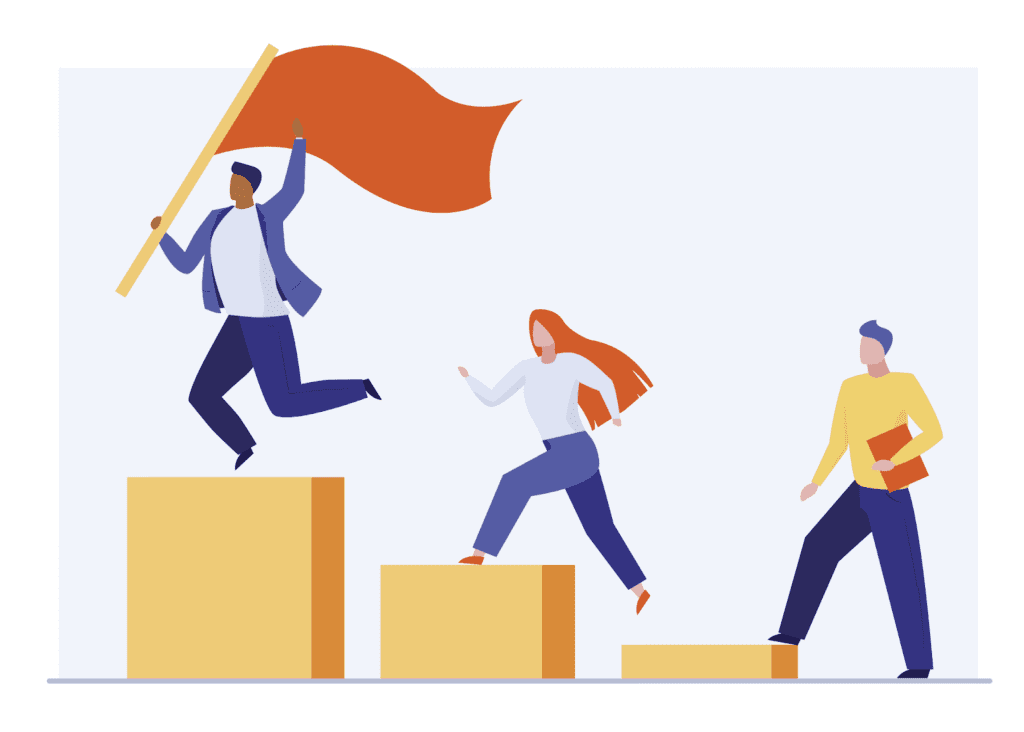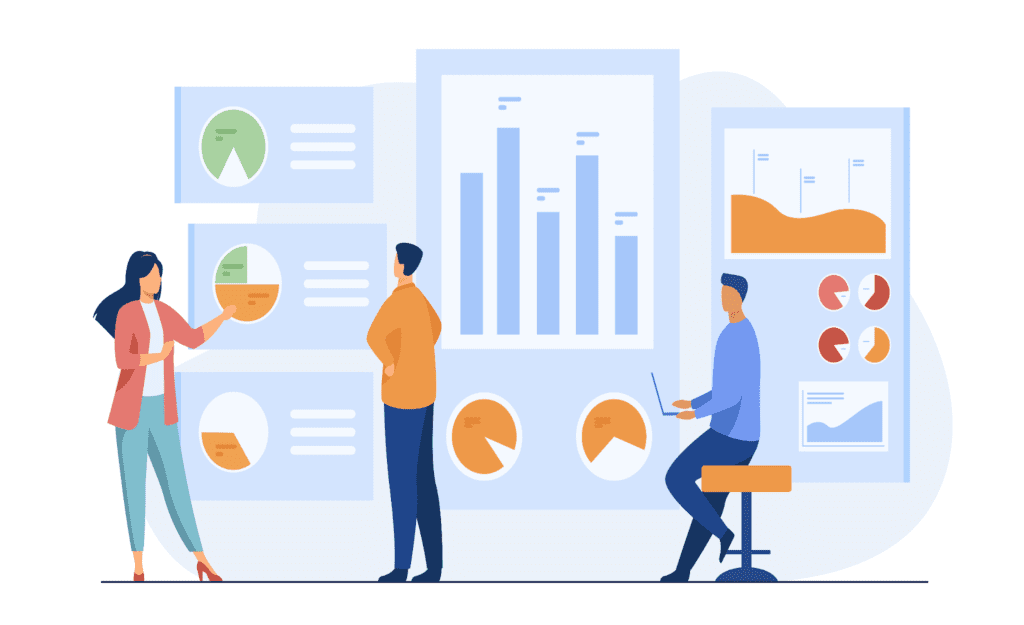Last updated on August 2nd, 2023

In this ultimate guide, you’ll learn how to create a practical sales playbook that’ll be the helpful blueprint to sales organization success.
When you look at sports teams, they have protocols and “plays” they run for specific situations to maximize their chances of success.
When you look at business, it’s no different.
Successful companies have a “sales playbook” they adhere to in order to win deals.
And whether you want to scale your sales team with more reps, become more consistent, or just win more deals — a well-designed sales playbook will be your keys to success.
If you:
- Have a sales team that seems inharmonious and disorganized
- Don’t have a go-to resource for sales training
- Don’t know where to start as far as improving your sales cycle
Then this guide is for you!
You’ll learn:
- What Is A Sales Playbook?
- Why Is A Sales Playbook Crucial In The First Place?
- A Deeper Dive: What Is Included In A Sales Playbook?
- How Do I Make A Sales Playbook?: A 7-Step Blueprint
- Final Thoughts: How To Assess Sales Playbook Effectiveness Using Data

VipeCloud is the only Automation tool your small business needs to
be the hero to your customers.
With Email, Texting, Social, Suites, Chat, Stories, Video Email & Sign Up Forms fully built-in, we provide you with the perfect platform to grow your business.
15 Day Free Trial – Get started risk free. No CC needed.
What Is A Sales Playbook?
A sales playbook is a framework for selling that a company or sales team implements to best reach their goals.
It details what reps should do during particular sales situations to maximize their efforts.
A sales playbook also includes sales enablement materials that help reps flourish. Of course, you could hire the best sales team in the world, but without helpful resources, mistakes are a guarantee.
So what exactly are these “sales enablement materials?”
They include but are not limited to:
- Email templates
- Call and sales scripts
- Elevator pitches
- Value propositions
- Demos
- Lead qualification questions
- Customer profiles
- Sales Engagement protocols
Don’t worry if some of this is going over your head, we’ll do a deeper dive soon.
But first, let’s talk about why exact sales playbooks are so crucial for your organization.
Why Is A Sales Playbook Crucial In The First Place?

1. Makes Sales Training More Effective And Consistent
The first (and foremost) benefit of sales playbooks is how they make training fruitful and consistent.
For starters, they outline all the key information a rep will need to be successful:
- Sales methodologies (SPIN, BANT, Gap Selling, etc.)
- Product information
- Manuals and video training
Just to name a few.
With a holistic approach to training, reps are better equipped to handle a wider variety of deals!
As far as consistency, each rep is trained in the same manner so sales leaders can better grasp and isolate each rep’s strengths and weaknesses.
Your reps shouldn’t be required to go out and seek sales training information on their own.
This could potentially lead to them learning bad practices, unproven sales techniques, and poor habits.
2. Situational Training Helps Recollect Information Better
The best sales playbooks have “situational training.”
Your burning question is probably: What’s situational training exactly?
Situational training is when a company’s sales manual or video outlines specific steps to take in a specific sales situation.
For example, it can be what a rep should do during a particular type of objection.
Say your rep Thomas is on a sales call, and his prospect objects, saying: “This product is too expensive.”
Thomas gets slightly unsettled, but he remembers your sales training about this particular objection.
He recalls your sales playbook saying to acknowledge what the prospect is saying, ask follow-up questions and show the product’s value against the objection.
See how he would be better able to handle the objection?
All thanks to your sales playbook — it can mean the difference between a won deal or a lost one.
3. It Helps Better Advance The Sales Process
With your reps improving in performance thanks to your sales playbook, your sales deals speed up.
This means your sales team is closing deals faster or spending less time on unqualified prospects.
For example, including a tool like lead scoring in your playbook is one of the best ways to ensure your sales team remains efficient.
Did you know that nurtured leads have a 47% higher order value than leads who aren’t nurtured?

Lead scoring helps you spend time on the most important deals and to gauge which leads need more nurturing.
A Deeper Dive: What Is Included In A Sales Playbook?
Earlier, we sprinkled some things you can expect in a sales playbook.
In this section, we’ll do a deeper dive into the most important things your sales playbook should have.
- Product/service information – A detailed explanation of what your reps are selling. Product price, what does your product/service do? Why is it important? What are the features and benefits?
- Value proposition – This is a statement that differentiates your product/service from competitors. To make a great value proposition, figure out what problems, fears and needs you solve. Then mention how you’re different, how do you make things easier than competitors in your industry? What guarantee can you give your customers that others simply can’t?
- Company guidelines and information – Details about the company and its background. Mission statements, values, founders, company expertise. The “why” behind the company. This helps reps understand the company culture and how they fit into it.
- Sales protocols – Sales scenarios and procedures. How to manage prospects, run & set up sales calls, and handle objections. Even how to word services in a way that conveys the value.
- Elevator pitch – A brief (20-40 second) description of who you are, what you do, and how the prospect can benefit from your service or simply giving you more of their time.
Be sure to think about the end goal of your elevator pitch (Is it for networking? Setting up a call? etc.) Mention what makes your service standout/unique, and incorporate your value proposition.
End your elevator pitch with a question that reels in your listener’s input.
Example: “My company helps entrepreneurs hire the best trained assistant’s through our assistant matching app.
Unlike other hiring agencies, we have the lowest fees and our clientele has grown 33% in the past 6 months.
I’m curious, what’s your hiring process like?”
- Sales models or methodologies of the company – Type of sales framework the company uses. BANT sales, Gap selling, Socratic selling, etc. Sales methodologies are reflected in the questions reps ask.
- Sales organization structure – The hierarchy and anatomy of the sales team (sales reps, sales managers, sales directors, VP of sales, CEO.) Also, how the sales teams are divided (Island, assembly line, pod, geographical.) It helps reps understand their role in the grand scheme of things.
- Sales enablement resources – Value propositions, elevator pitches, email templates, price sheets, discovery questions, objection handling, CRM tools. Helps maximize sales efforts.
- Demos – Images, manuals, or video “How-to’s.” Training materials that reps can revisit and refresh their knowledge.
- Customer profiles – Information on the company’s ideal customers. (Age, occupation, title, location, interests, pain points.) This gives reps and new hires key attributes to look for when prospecting and qualifying.
- Communications – How the company communicates and relays information: software used, communication expectations, meetings, in-person training, role plays, etc.
- Company “plays” or workflows – These are what reps must do in each stage of the sales cycle: inbound or outbound lead generation, qualifying, discovery calls, demos, presentations, objection handling, quoting, and closing. This allows for consistency across the company! It also includes situational training.
- KPI goals and expectations – Sales playbooks outline what KPIs sales reps are expected to reach and timeframes. With KPI goals in mind, sales reps can better manage their time, be more productive, and be strategic about open deals.
How Do I Make A Sales Playbook?: A 7-Step Blueprint

1. Outline Your Playbook And Current Sales Process
This is important because you want to get an understanding of your starting point. Do an audit of what your current sales process consists of and what reps tend to already know.
Talk with partners, reps, your marketing team, managers, and so on to get as much input as possible.
After all, they may be seeing things you don’t.
Breaking down your sales process from beginning to end and looking at your analytics can help you grasp what you need to make things better.
On your outline, make a note of:
- What your sales playbook will consist of
- What you’ll need to accomplish each part of the sales playbook
- Notes from speaking with partners, contractors, and employees
- Timetables for completing the sales playbook in its entirety
2. Know Your Customers And Write Details About Them
Make sure you know your market like the back of your hand.
Your sales playbook should accurately describe who they are so a rep’s “antennas” go up when they’re prospecting someone that matches the description.
Also:
Look at your past and current customers to get a targeted idea of your ideal customers.
And if you serve a somewhat diverse marketplace, make a note of commonalities…
Your CRM is one of the BEST resources to do this.
3. Create Your Sales Enablement Materials
Companies that use sales enablement have a 6.5% higher win rate on forecasted deals than sales organizations without!
In just 2 quarters, that’s A LOT more revenue.
As I mentioned earlier, sales enablement is the resources your reps and new hires will apply to sales situations/processes.
These enablement materials not only train your reps but allow them to add value to the customer.
First, you want to make a list of all your most important sales enablement materials. To make this list as accurate as possible, simply break down your sales cycle and think of what reps will need in each part of the cycle.
Here’s an example, let’s say a small business B2B firm has the following sales cycle:
- Stage 1: Outbound/Inbound prospecting → Resource: email templates, cold call scripts, landing page link, elevator pitch, CRM.
- Stage 2: Qualifying → Resources: Discovery call/qualification questions, product information, CRM tool instructions, lead scoring “How-to’s”
- Stage 3: Presentation → Resources: Powerpoint slides, proposals, value proposition, testimonials, sales methodology sheet.
- Stage 4: Nurturing → Resources: Touchpoint best practices, follow-up email templates, educational content
- Stage 5: Closing → Resources: objection handling resources, contracts, quoting/invoicing tools.
- Stage 6: Onboarding → Resources: onboarding documents, submission deadline documents
See how each stage is associated with particular documents?
All in place to make the job of your sales staff easier and help the customer buying journey to be smooth as silk.
Now, some materials are best made in a PDF format while others like tutorials, for instance, are better in video form.
As time goes one, your reps will interact with prospects
Lastly, You want to give a “why” behind what you’re training your organization on.
For instance, explain how and why your sales methodology works!
The “why” behind your sales enablement materials will give reps a better understanding of things and a higher likelihood of sticking with your best practices.
4. Create Your Plays
Next, it’s all about your plays.
Think of your organization as a championship team, and you’ll eventually act like it!
Your plays are action-steps for reps to take during sales cycle stages (essentially what rep’s should be doing.)
Here’s a B2B example:
- Stage 1: Outbound/Inbound prospecting → Play: “Send 15 LinkedIn connections a day. Make X amount of cold calls in X amount of hours.”
- Stage 2: Qualifying → Play: “Ask prospects these specific questions. If they’re qualified, set a time to speak 2 days later, if they’re not qualified, send them these helpful resources.”
- Stage 3: Presentation → Play: “Demo the service, show these testimonials, ask clarifying questions, ask for the sale at the end”
- Stage 4: Nurturing → Play: “Follow-up 5 times within 30 days via phone and email. Send “learn more” materials, ask for a follow-up call.”
- Stage 5: Closing → Play: “Send contracts digitally, only quote using the CPQ system, follow-up if nothing is signed after 3 days.”
- Stage 6: Onboarding → Play: “Send onboarding documents after kick-off call, Make sure welcome email automation is sent.”
Again, plays are super important because it keeps things predictable!
When creating your plays, think of the following:
- What are my expectations for each part of our sales cycle?
- What specific scenarios can I cover so my team can recall it later?
When everyone is following protocols, you can make better distinctions as to why one person isn’t performing as well as another.
With plays that are face-to-face “rep to customer” conversations, It’s vital to practice them during meetings so they get ingrained in the minds of your team.
The most important plays to adjust will be on the stages that aren’t producing results. For instance, if your nurturing sequences aren’t working, test out a different approach to get more prospects interested in another call.
5. Mention Your KPIs & Goals
Your sales playbook should mention KPIs your reps should aim for.
(As well as what timeframes (week, month, etc.) those numbers should be reached.)
Here are some ideas to get you started:
- Discover calls per week/month
- Revenue benchmarks
- Number of Deals won/closed
- Touchpoints per prospect
- Average purchase value
- Opportunity-to-win ratio
One of the best ways of staying on top of your numbers is with VipeCloud’s Sales CRM.

See all your deals very quickly, create multiple pipelines and survey your sales effectiveness all in one place!
6. Look Into Successful Companies
There is a boatload of successful sales organizations out there!
With a keen eye, you can pick up what’s working for them and figure out how to tailor it to your organization.
There’s a high chance that they’ve thought of something you (or I) haven’t thought of.
Maybe it’s a sales methodology, email template, or sales structure…
Whatever the case, there’s always something to learn.
(…and If you’re a small business, you can still adopt some valuable things from more prominent enterprise companies.)
You can find these businesses online, at conferences, networking events, and more.
Tap into your inner social butterfly and ask beneficial questions when networking!
7. Review And Revise Your Playbook
The final step of your sales playbook is to review and revise all your materials. Be open to feedback from reps and partners during this review process.
Then, through time, analyze the success of your playbook, and see where you can make improvements,
There’s a high chance you’ll have to update things periodically.
“The biggest room in the world is the room for improvement.”
– Helmut Schmidt
Final thoughts: How To Assess Sales Playbook Effectiveness Using Data

Your sales playbook is the backbone of sales organization success.
It will likely go through multiple iterations as time goes on, and make a note of what the data is telling you.
Are your KPIs being reached or exceeded?
Is your team learning and implementing valuable practices?
When analyzing the effectiveness of your playbook, VipeCloud’s unmatched Sales CRM lets you easily see sales reports.

Use it to bring efficiency to your organization and compare your data since implementing your sales playbook!
And guess what?
Manage your team effectively with task management.
You can even adopt information from our experts to implement into your playbook!
Try VipeCloud’s Sales CRM today for a free 15-days! (No card required)
You can also request a free demo.

Leave a Reply